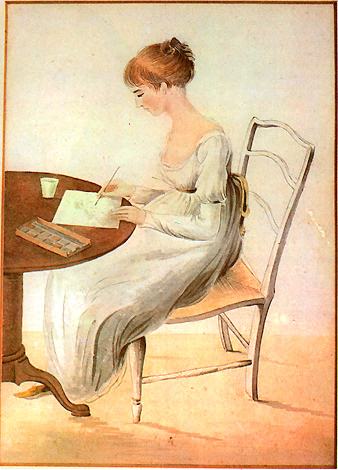L&T Archive 1998-2003
 From about 1800-1805 especially (but also to some degree through the whole period) wearing white was kind of the fashionable trend. Obviously all women didn't wear white all the time, and their removable outergarments if they went outdoors (i.e. Pelisses, Spencers, etc.) would not have been white, but white was one Paris-derived fashion trend that was suitable to be thoroughly adopted by all genteel Englishwomen (including Jane Austen's "country gentlewomen"). This was different from many other Parisian high-fashion trends of those years (such as diaphanous gowns with few undergarments, or sleeveless straps which did not cover the shoulder joints, or exceedingly low necklines), which were considered quite unsuitable for public wear in England.
From about 1800-1805 especially (but also to some degree through the whole period) wearing white was kind of the fashionable trend. Obviously all women didn't wear white all the time, and their removable outergarments if they went outdoors (i.e. Pelisses, Spencers, etc.) would not have been white, but white was one Paris-derived fashion trend that was suitable to be thoroughly adopted by all genteel Englishwomen (including Jane Austen's "country gentlewomen"). This was different from many other Parisian high-fashion trends of those years (such as diaphanous gowns with few undergarments, or sleeveless straps which did not cover the shoulder joints, or exceedingly low necklines), which were considered quite unsuitable for public wear in England.
At that time, women not of the genteel classes (servants, etc.) who wore white were considered to be presuming somewhat above their stations. In Mansfield Park, Mrs. Rushworth's houskeeper "turned away two housemaids for wearing white gowns", and the following letter appeared in The Lady's Monthly Museum or Polite Repository in October 1801:
To the Editor
SIR,
Can any of your correspondents inform me what is become of the race of plain-dressing, docile and obedient beings who formerly served as cooks, or housemaids, or maids of all work, in a family? I have lately lost an old servant who lived with me nearly twenty-five years; and, though I never expected to meet with such another, I at least thought I might meet with something like her. During a late excursion to Brighton I enquired, as I passed through the Weald of Sussex; when to my astonishment, I found nothing but young ladies, delicately arrayed in white, with their heads a` la Brutus, who declared they were all anxious for places, and wished to go out to service.
One of them informed me that she had lately left her place, and could have an excellent character, her only reason for quitting being that her mistress did not suffer her to drink tea twice a day, and could not abide her wearing feathers in her hat on Sunday.
Mr. Sheridan informs us in The Critic that when Queens or Queens or heroines go mad they usually do so in white satin; I suppose therefore that village maidens when they go mad content themselves with white calico.
Yours,
PREVENTER
The real clothing color faux pas in the movie adaptations is Jane Fiarfax plain all-black dress in Emma3; in Regency times, it would have been quite inappropriate for Jane Fairfax to wear such a dress, unless she was in deep mourning only.
Here's a portrait of Jane Austen's niece Fanny by her sister Cassandra (probably around 1810):

Messages In This Thread
- Shallow as a pond...
- Colours and fashion
- I have always wondered about
- We are told..
- No man made fabrics in those days
- But lots of pollution
- The Great White Debate
- Those pesky brackets
- Don't ask......
- White
- Everyday fabrics, dark colors
- Don't ask......
- Indoors as well
- Those pesky brackets
- Cleanliness
- The Great White Debate
- Some more clothing observations
- Wearing white... (Fashion styles)
- Thanks
- No man made fabrics in those days
- You will find this link interesting nfm
- We are told..
- I have always wondered about
- Colours and fashion